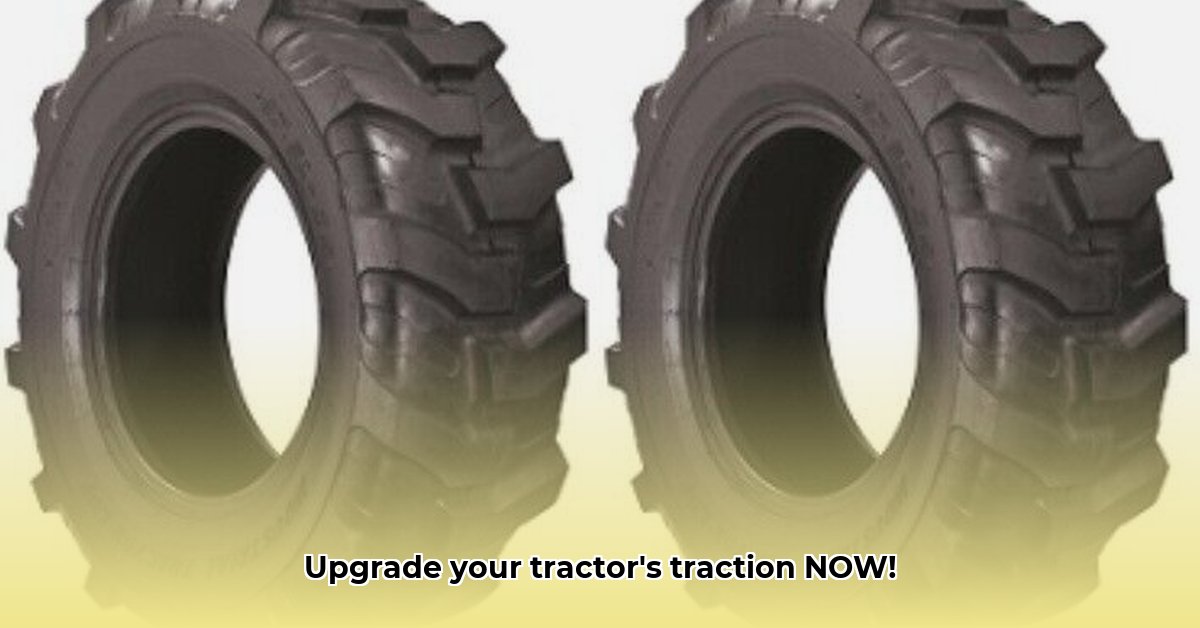
Choosing the right 17.5L-24 tractor tire is crucial for maximizing farm productivity and minimizing operational costs. This comprehensive guide navigates the complexities of tire selection, providing actionable advice for both seasoned farmers and newcomers alike. We'll examine key performance metrics, compare leading brands, and offer a step-by-step selection process, ensuring you find the perfect tire for your needs and budget. For even more tire information, check out this helpful resource.
Decoding Tire Performance: Beyond the Numbers
Tire selection hinges on understanding several key performance metrics. While "easy test scores" offer a convenient summary, a deeper dive reveals the contributing factors:
Treadwear: This metric reflects a tire's lifespan. High treadwear translates to longer service life, reducing replacement costs and downtime. A longer-lasting tire means fewer interruptions to your workflow and lower long-term expenses.
Traction: Good traction ensures safe and efficient operation across diverse terrains. Superior grip minimizes slippage, leading to improved fuel efficiency and reduced risk of accidents, particularly in wet or muddy conditions. This is critical for productivity and safety.
Expert Ratings: Independent assessments from industry professionals and experts add credibility to performance claims. These reviews provide valuable insight into real-world performance beyond manufacturer specifications.
Ply Rating: This indicates a tire's load-carrying capacity. A higher ply rating signifies increased strength and resilience, essential for handling heavier loads common in agricultural applications. A 10-ply tire, for instance, is significantly more robust than an 8-ply tire which might be sufficient for lighter work. Choosing the correct ply rating is directly tied to preventing tire failure.
UTQG Scores: The Uniform Tire Quality Grading system provides numerical ratings for treadwear, traction, and temperature resistance. While helpful, UTQG scores should be considered alongside other performance metrics for a holistic assessment. Higher scores generally indicate better performance, but remember they’re one piece of a bigger puzzle.
Brand Comparison: A Look at the Market Leaders
Several leading brands dominate the 17.5L-24 tractor tire market. While precise pricing varies based on retailer and specific model, we can compare key performance characteristics. Remember, data availability varies across brands and models.
| Brand | Typical Performance | Ply Rating Options | General Comments |
|---|---|---|---|
| Carlisle | Premium | 10PLY and higher | High-quality, known for longer tread life, often higher initial cost |
| Ascenso | Excellent to Great | 8PLY and 10PLY | Solid performance at a more competitive price point |
| Galaxy | Excellent to Great | 8PLY and 10PLY | Often a budget-friendly choice while maintaining decent performance |
| Alliance | Excellent to Great | 8PLY and 10PLY | Reliable and durable; a consistent performer. |
| Titan | Excellent to Great | 8PLY and 10PLY | Consistent quality and reliable performance |
| BKT | Excellent to Great | 8PLY and 10PLY | Known for competitive pricing and a good range of offerings |
(Note: Ply rating options are examples and may vary depending on the specific tire model. Always check the manufacturer’s specifications.)
Pricing and Value: Finding the Right Balance
Premium brands generally command higher prices, reflecting their superior materials and construction, leading to extended lifespan and reduced long-term costs. However, budget-friendly brands offer capable performance for less intensive applications. The optimal choice depends on your specific operational needs and budget constraints. A heavier-duty application necessitates a premium tire, even with its higher initial cost.
Buying Guide: A Step-by-Step Approach
Selecting the right tire is a multi-step process:
Assess Your Needs: What type of work demands the most from your tires? What are your typical load requirements? What kind of terrain do you typically navigate?
Define Your Budget: Determine a realistic budget based on your operational needs and financial resources. Consider the total cost of ownership including the initial purchase price, expected lifespan and potential downtime due to replacements.
Research Thoroughly: Compare specifications, read reviews, and consult the information in this guide and other resources to compare features.
Verify Compatibility: Ensure compatibility of the tires with your tractor's rims and other specifications.
Purchase from a Reputable Dealer: This will ensure authenticity and access to warranties.
Risk Mitigation: Avoiding Common Problems
Several issues can arise if you don't take proper precautions:
Tire Failure: Overloading, underinflation, and lack of regular inspection can lead to catastrophic failure. Always maintain correct inflation pressure and regularly inspect for signs of wear or damage. This is crucial for safety and avoiding costly repairs or replacements.
Rim Compatibility: Improper rim matching can lead to tire instability and potential damage to both the tire and the rim, resulting in safety or performance issues.
Conclusion: The Importance of Informed Decisions
Selecting the right 17.5L-24 tractor tire is an investment in your farm's efficiency and profitability. By meticulously considering all aspects—performance, price, and potential risks—you can ensure you make the most informed choice, optimizing uptime, reducing costs, and maximizing your overall productivity.